What is wool? An in-depth guide to where wool comes from and how it is produced- following the process sheep to clothing.
What is Wool?
Wool is the fiber (fleece) collected from wool sheep via the process of shearing, although there are rabbits, goats, camels, alpacas, and llamas whose hair is also used as wool.
Below is a photo of one of my sheep, laying on her side calmly while our shearer shaves her.
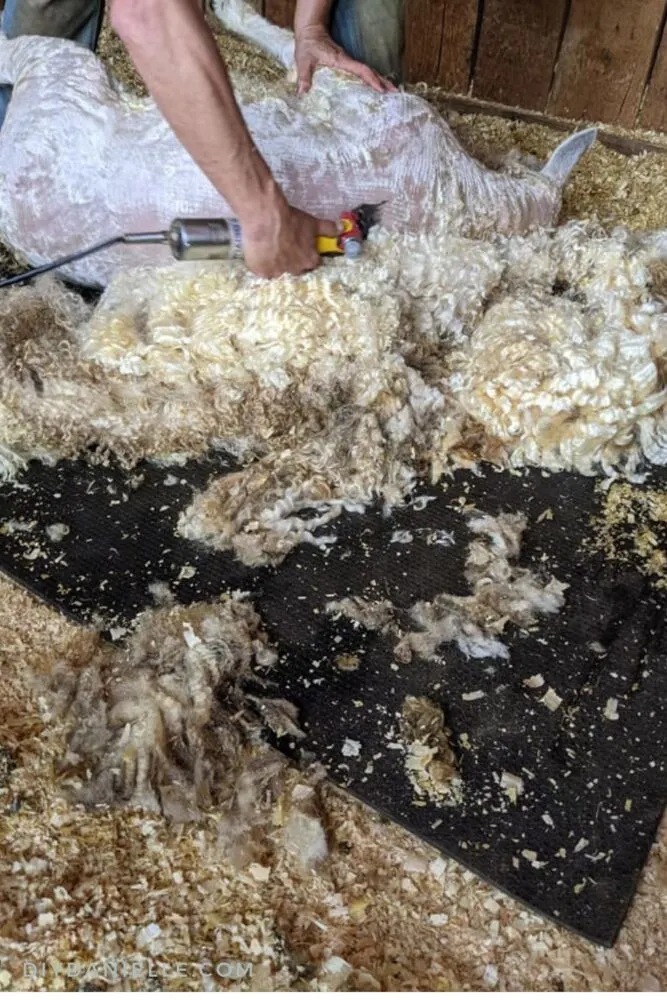
Wool is NOT a sheepskin. A sheepskin is a product that you get when the animal was butchered and their skin, attached to the fleece, was removed.
Is Wool Ethical?
Sheep live around 10-12 years. If they are sheared on our schedule of twice per year, they’d be sheared around 20-24 times in their life, providing a lot of wool in the process. As this is a 5-10 minute hair cut with an experienced shearer, they’re looking at about 240 minutes (4 hours) of “work” in their lives at most.
I feel it’s a very renewable resource and if you treat your sheep well, it can be quite a good life for them. They get to enjoy living on pasture, mowing the lawn, they make babies, and once or twice a year they’re given a hair cut. It’s not a bad deal, at least when compared to other farm animals.
I cannot speak to the ethics of factory farming wool, but I imagine it is most economical and the least amount of work, to keep wool sheep on pasture 24/7, so I think this is one animal product where the math works in the animal’s favor.
Thinking about this, I’m wondering if I’d like to request being a wool sheep in my next life?
Of course, the best way to know for sure that the animals are being treated kindly is to either raise them yourself, or buy from a local farmer who allows you to see their farm setup.
Below are two Cotswold sheep waiting to be sheared.
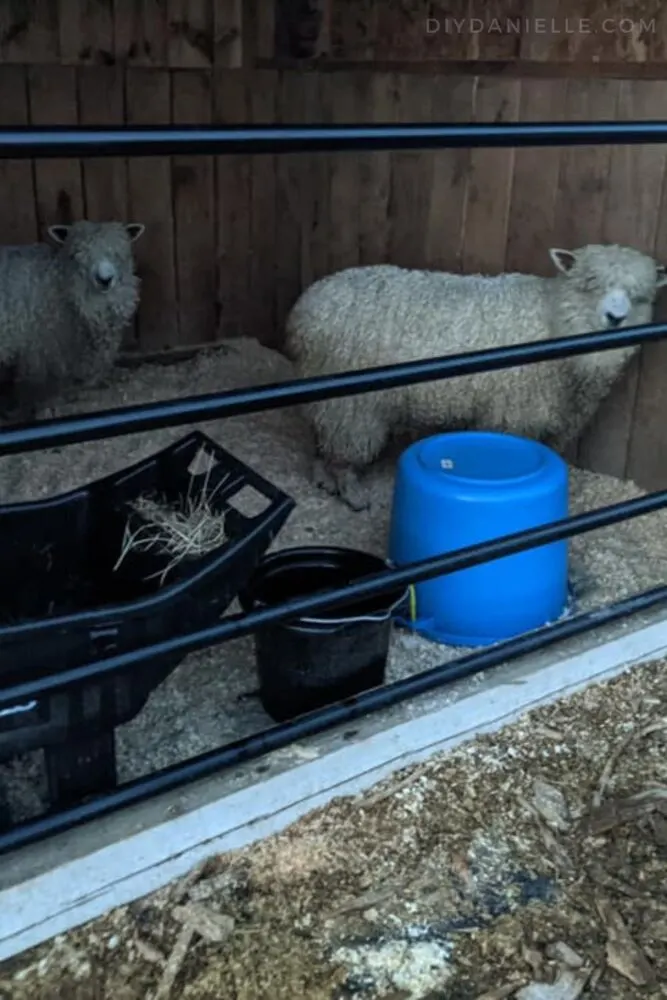
Here’s their “after” photo!
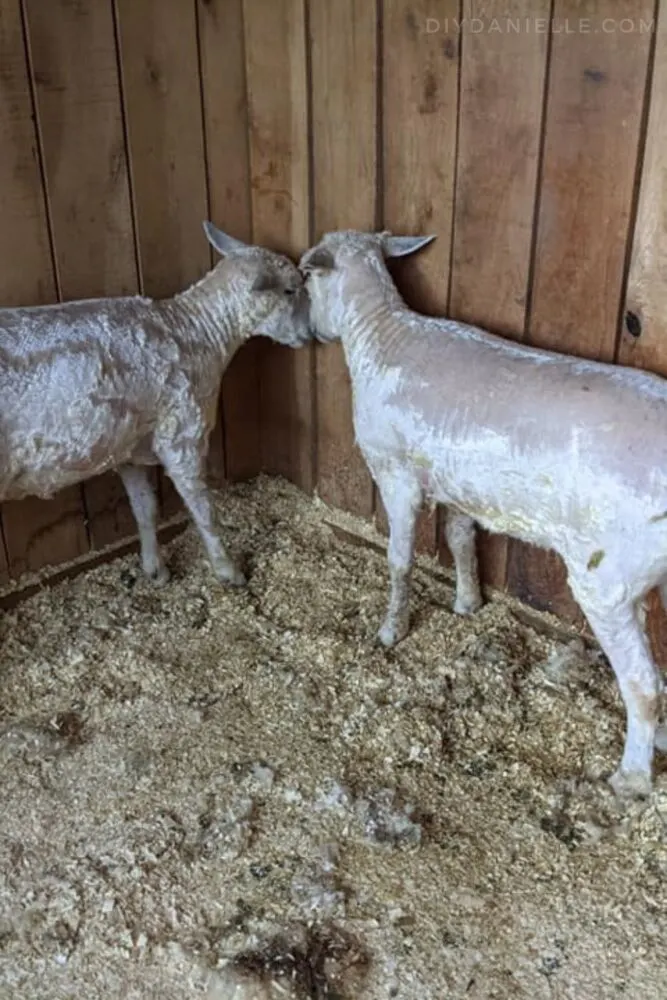
Wool Sheep vs. Hair Sheep
All sheep have both wool and hair fibers. Wool sheep have more wool fibers, and hair sheep have more hair fibers. The wool sheep that we know today was selectively bred to have more wool fibers, and they MUST BE SHEARED. It would be unethical to not shear a wool sheep.
Hair sheep are sheep that shed. They’re primarily used for meat or kept as pets.
Hair sheep do not need to be sheared, and I believe they’re closer to their undomesticated ancestors.
Why Use Wool?
Wool is a natural product that can keep you warm, it’s ecofriendly, biodegradable, and it’s a renewable resource. While raising sheep can use a lot of land, you can raise sheep on silvopasture (raising them in the woods or in an established orchard), they can graze under solar panels, and there are lots of ways to make dual use of the land.
Wool Quality
Different types of sheep produce different qualities of wool. Angora goats, for example, produce a very nice quality wool that’s used for clothing that is kept closer to your body. Some breeds of sheep produce wool that is better for blankets, others produce wool for wool insulation, etc. Not all wool is the same.
Some of the yarn you may have used and found scratchy might not even be wool! Yarn can be made from cotton, acrylic, linen (flax), wool, and other types of fibers that come from animals or even plants. Acrylic is a synthetic fiber made from fossil fuels (yeah you heard that correctly); it’s essentially plastic.
What is Lanolin?
Lanolin is a wax that the sheep have in their wool. Sheep have glands that produce the wax, and it helps keep their wool dry. This waxy substance keeps sheep from becoming a giant walking sponge; the water simply sheds off their wool.
This is why you generally should not wash sheep. Washing them with soap will remove the lanolin.
Lanolin is used in many skincare products to help hold moisture into the skin. Lanolin can be extracted from the wool after the sheep has been sheared, although I don’t personally do this.
Sometimes during the shearing process, but more often when I’m skirting the wool, I’ll find my hands covered in the wax.
It’s interesting how many useful products can be used from what sheep produce.
Shearing Sheep
Shearing is the process of clipping a sheep’s hair. A shearer or farmer uses clippers to clip off the sheep’s wool, leaving them with a shorter coat that’s more comfortable for warm weather.
In any farm that raises their sheep ethically, this should not be a harmful process to the sheep. About 12 hours prior to shearing, the farmer withholds food so the sheep aren’t shorn on a full stomach. This may sound cruel, but they are more comfortable being shorn on an empty stomach as they’ll be on their back for part of the process.
An experienced sheep shearer can shear the sheep in 5 minutes. One of the reasons many people hire a shearer is because it’s much more comfortable for the sheep vs. the one hour it might take a novice to shear.
Elsa being sheared this year. This lamb LOVES attention so she was hamming it up.
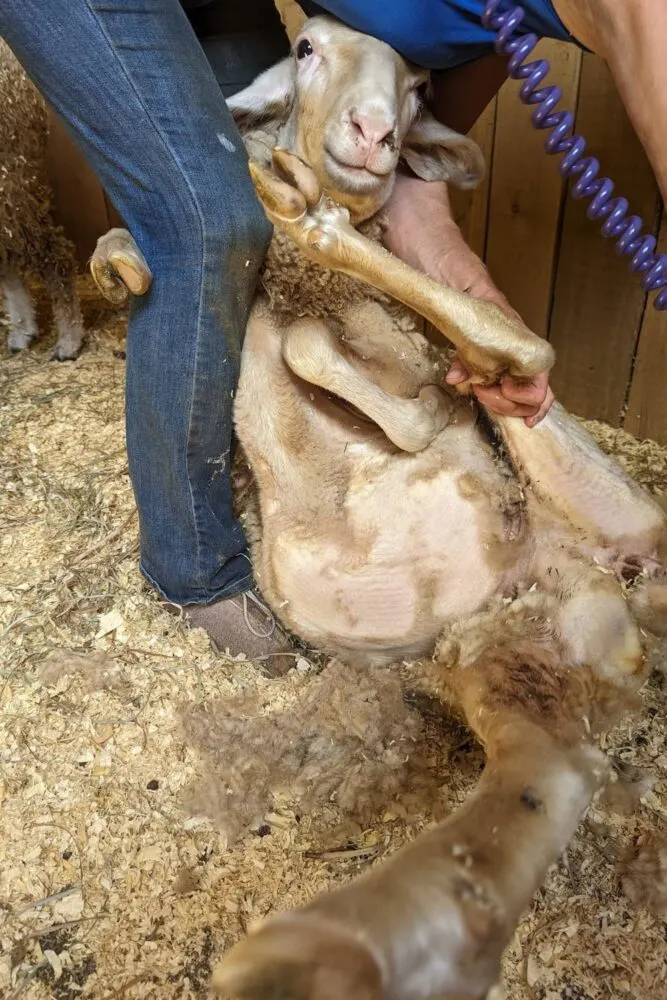
Sheep spend the majority of their life out on pasture, although this can differ depending on the farm. Some sheep are bred for milk, while others are bred for their fleece. Some sheep, Hair Sheep, don’t need to be sheared- these sheep are generally used for meat.
Some people choose to sheer their own sheep while others hire a professional sheerer to clip their sheep. I hire the job out as I don’t own clippers (yet). Our shearer comes to shear our sheep in the Spring and Fall. In some climates and with some breeds of sheep, you may only shear twice a year, but our sheep get quite uncomfortable in our Maryland weather if their wool gets too long. They always seem happier after shearing so I have continued with the twice a year shearing.
The longer sheep go without sheering the longer their wool gets which can be beneficial, but the wool can also get matted and the sheep may get uncomfortable.
@doityourselfdanielle shearing day! they’ll be much more comfy now for summer! #sheep #sheepofinstagram #sheep #sheep🐑 #cotswolds #homesteadinglife #homestead ♬ Promises (Skrillex & Nero Remix) – Skrillex / Nero
Skirting Wool
Skirting wool is the process of going through all of the wool that has been sheared off and removing any icky pieces. You’d be surprised at how little wool is gross!
@doityourselfdanielle skirting fleece from my sheep… essentially getting rid of the icky stuff. 🥰 the icky stuff goes into mud by barn for mud control. #sheep #farmher ♬ Paradise – Ikson
Usually by the end of the process, my hands are covered in lanolin from handling the raw fleece. Essentially skirting involves moisturizing my hands! Not a bad gig.
Here’s a photo from the day I skirted my fleece…
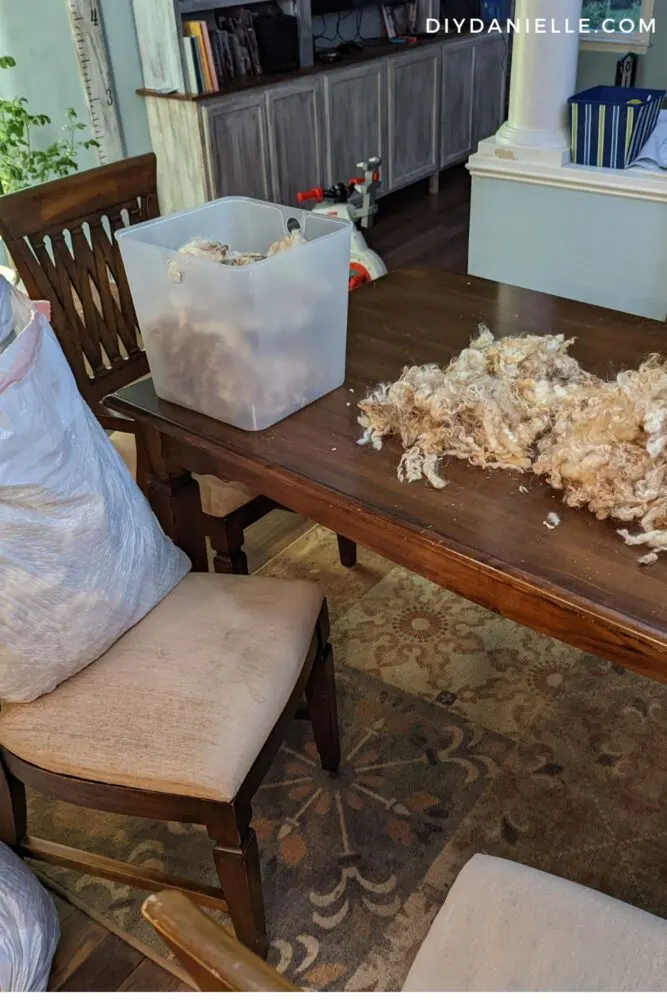
Yucky wool leftover from the skirting process can be composting, used at the bottom of a garden bed, or added around the trees as a mulch (but don’t place it too close to the trunk of the tree).
Washing Wool
Wool is tricky to wash because you need to wash it without accidentally felting the wool. Washing it removes dirt, as well as the lanolin.
After skirting the wool and removing all of the gross bits (which can be tossed into the compost bin or used for mud control), you need to wash the wool. You can send the wool out to be washed if you wish, but it’s always good to do an initial wash if you do. The initial wash removes the lanolin and excess dirt, and the wool will cost you less to process at the processing mill because it will weigh less.
Tips for Washing Wool
- Make sure not to accidentally felt the wool with excess agitation.
- Use natural detergent such as Kirkland Free and Clear.
- You can use your bathtub to wash or use a big plastic storage bin to do the washing outdoors.
If you opt to wash the wool yourself, you’ll be doing three wash cycles. If you use your washing machine, you’ll need to make sure your machine DOES NOT AGITATE THE WOOL. Otherwise it will felt. Most people wash by hand to avoid this issue.
Start by putting your skirted wool in a tub of hot water with your soap (natural detergent). If the water is running into the tub with the wool already in it, make sure your running water isn’t hitting the wool (it will felt). I was told to put a colander under the faucet and on top of the wool.
Let soak for around 30 minutes. Empty tub. Refill with hot water. Let soak another 30 minutes.
If the wool still feels sticky after the 2nd rinse is done, repeat the soap wash and do two more rinse cycles.
Otherwise, do one more soak in hot water with no soap for 30 minutes. Empty.
After rinsing, let dry. Try to spread the fleece out so it can dry quickly.
Carding Fleece
Carding fleece is the process of combing the wool into roving. Once combed out, it looks like the photo below. I usually send my wool out for this process as it’s time consuming and I don’t have carding tools yet.

Once carded, you can use a process called felting to turn the fleece into a product such as a blanket, toy, or piece of clothing.
Article Suggestion: What Is Felting?
If you don’t want to felt the fleece, you spin it into yarn.
Dyeing Wool Roving
Recently I’ve been making a lot of felted soap and thus, I needed to dye my wool roving. I use standard dyes made for natural fabric such as wool and follow the directions on the container. I use gloves and it’s a fun and interesting process.

Fleece to Fabric
Once carded, fleece can be spun into yarn. This is a pretty time-intensive practice when done by hand, but fortunately machines are able to do much of the work now. For those who really enjoy and are invested in the process to make products from scratch, spinning can be a soothing pastime.
After the fleece is turned into yarn, you can knit, crochet, or weave the yarn into a fabric. Woven fabric can be sewn into clothing or other items. Knitting and crochet involves making the product during the process.
Another option is to felt the wool roving. Here’s a tutorial on What is Felting? Felting is the process of getting the fibers of the roving to mesh together to create felted soap, scarves, blankets, and more.
Alternative Uses for Raw Wool
One alternative use for raw wool is as a mulch for the garden. I love this, particularly for the ‘garbage’ portions of the wool left from shearing- this is the stuff that gets skirted out. It has a lot of organic matter that will be good for growing soil health, and also works well as a mulch alternative.
Wool also is good for controlling mud in paddocks and areas of your property that have issues with water drainage.
Wool Products to Make
- Clothing like therapeutic wool underwear.
- Blankets
- Felted Soap
- Felted Toys and Decorations
- Wool Insulation (the real kind, not the itchy fiberglass kind): Read about the different types of insulation.
Please share and pin this post! If you make this project, share it in our Stuff Mama Makes Facebook Group. We have regular giveaways for gift cards to craft stores. You can also tag me on Instagram @doityourselfdanielle; I love seeing everything you make!

